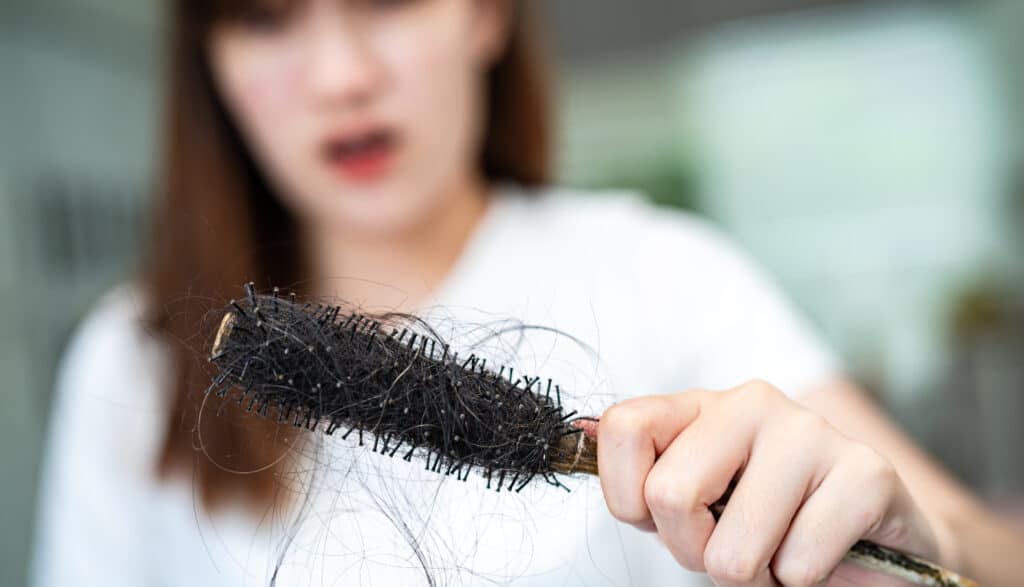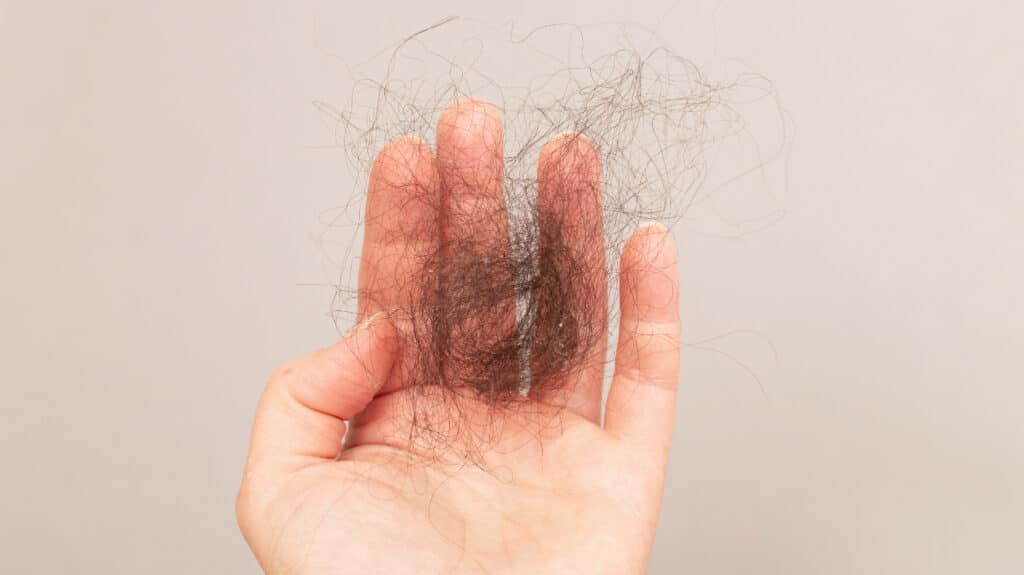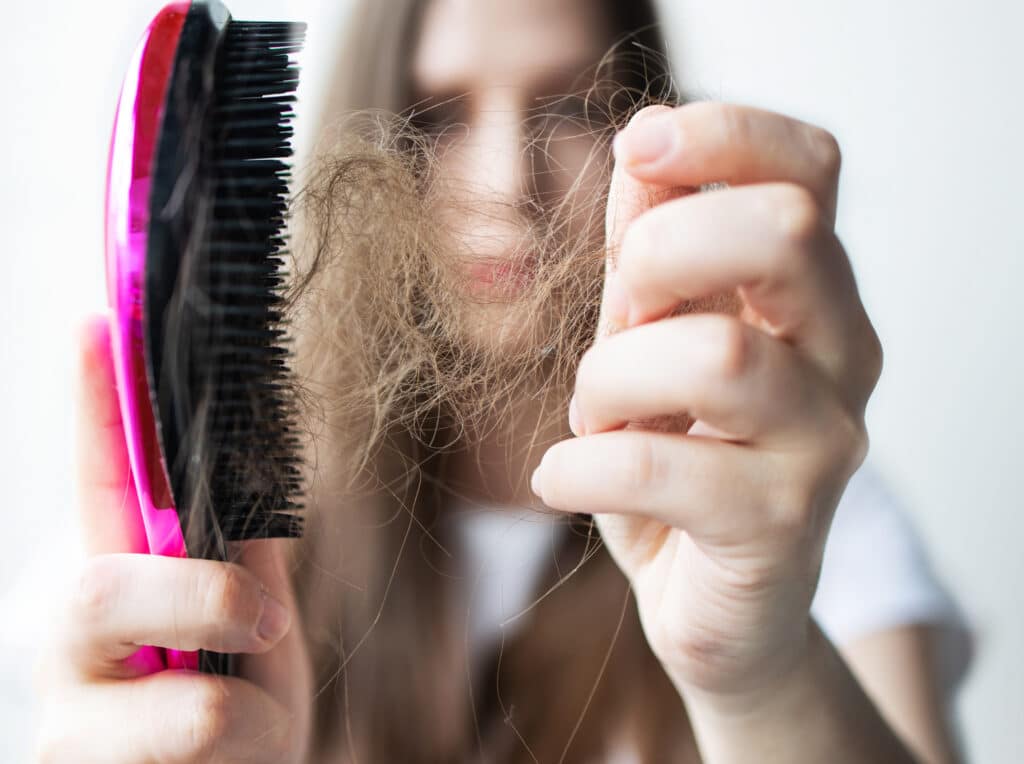Excessive hair shedding female or male, is becoming increasingly more common these days. It’s more common in women, but why? Let’s get to know what exactly happens to understand more about hair loss in women.
Hair Loss in Women
Everyone will lose hair everyday. It’s part and parcel of the lifecycle of hair. But, there’s a limit to what’s normal and what isn’t. Right? So much hair can we lose a day? When is it a problem? Let’s explore more, shall we?
Hair Loss in Women – An Overview
As much as 40% of the women are facing hair loss by the time they hit 50. However, this isn’t very well-known because women don’t face noticeable hair loss like men do. It’s more like a reduction in overall volume, thinning hair and the part looks wider. It’s also slower and happens over a period of time and sometimes in bursts. In some ways, it’s a blessing, but also why we take time to notice hair loss!

Signature Characteristics of Female Pattern Baldness
There are certain traits that are considered as signature traits or patterns for pattern hair loss in women. Want to know more?
Thinning
This is probably the first noticed trait – thinning of hair strands. Gradual thinning of hair starts at the top of one’s head and slowly progresses over a period of time.
Hair Part
Most of us take the center part, though there are variations too. Widening of the hair part comes next and is often dubbed as “Christmas Tree Pattern”.
Hairline
Receding hairline isn’t very apparent or jarring except in certain scenarios. It’s usually a mild recession of the hairline and not noticeable at the onset.
Hair Loss
Pattern of hair loss is different from men in that it starts with a receding hairline, then hair begins to thin at the top of the head and at this is the stage when most start to notice they’re losing hair! However, it rarely leads to complete baldness, unlike in men where partial or complete baldness is very common.
Stages & Progression
Ludwig classification describes pattern hair loss in women under three different types – Type I (minimal thinning), Type II (widening part and reduced volume), Type III (diffused thinning, with the top appearing more see-through).
Also, the progression of hair loss in women is usually gradual and happens more like thinning and rarely causes baldness. That’s probably why it’s often unnoticed at the beginning. Noticeable hair loss that happens in bursts can happen, but not often.
Scalp
This is another aspect that differs majorly between men and women when considering pattern hair loss. The scalp skin remains the same for women.
Even so, it is important to understand that not all hair loss is pattern hair loss. Sometimes, it’s just hair loss. However, getting a specialist’s help can make it easier to identify what’s the root cause and how to handle it. In such cases, it’s temporary hair loss and with timely interference can be reversed.
Causes
So, what are the causes of hair loss in women? Some causes are common for both men and women. Let’s take a look at what causes female hair loss.
Genes
Female pattern hair loss (FPHL) is one of the most common types of hair loss in women and affects a few million women every year. Unlike other hair loss types, this is a hereditary hair loss condition, though hormonal changes play a key role too.
Stress
Another common hair loss causative factor is stress! Is there anyone who doesn’t know stress? These days, it’s more common to be stressed than not! Ain’t it? This is a common factor for both men and women.
Did you know stress can affect your immune system and in turn it will attack your hair follicles? It can affect your hair growth cycle, too. Oh and it can push your hair into resting phase longer!
Aging
Aging is another common cause for hair shedding in women and men. Did you know hair follicles shrink with age? There are others that can cause this including wrong hair styles, hormones, certain treatments or drugs, etc.
Hormones
What about hormones? Can we really talk about us women, without discussing the good old hormones? Hormones, especially DHT is often the reason if your hair follicles shrink! We all know shrinking hair follicles lead to thin and weak hair, right? This left untreated can lead to hair loss.
What about menopause? Perimenopause? Pregnancy and Childbirth? All these times are when our hormones are haywire. Isn’t it? There are other conditions related to our hormones that also play a role in hair loss. PCOS anyone?
Tight Hairstyles
This is more common in women than men. Have you heard of traction alopecia? It’s due to damage to the hair follicles resulting in hair loss. This hair loss can be permanent, which means, hair regrowth is not possible.
Medical Conditions or Treatment
There are times when the hair loss could be due to a health condition or medication or treatments. Did you know radiation and chemotherapy damage hair follicles resulting in hair loss? While most may lose their hair fully leading to baldness, it’s usually a temporary hair loss phase.
Autoimmune diseases and even thyroid can cause hair loss. Autoimmune condition triggered hair fall may not always be permanent hair loss. Examples of autoimmune conditions include lupus, alopecia areata, etc. A specialist can help analyze what treatment options you have and if or not it can be reversed.
Hair Styling
Not just wearing tight hairstyles, did you know styling practices like heat and chemical treatments can cause hair loss? It’s also becoming a major contributing factor these days, what with styling becoming more common these days.
What about using hair dryers? Yes, they’re handy at times when you can’t leave your hair wet and don’t have time to air dry. But using it day in and day out, especially with heat can damage your hair and lead to hair loss and damage.
What about harsh coloring treatments? Bleaching? Hair coloring is done a lot these days, but there are safer and natural options for coloring. Why not those? Yes, the options are limited but you won’t be left with hair damage, isn’t it?
What about heat treatments like perming, straightening and more? Styling your hair once in a while for an occasion might not be as damaging, but doing it regularly is a real problem.
Though not common, hair shaft disorders can cause hair to be weak and brittle. Though all can be reversed, it’s usually treatable. Styling is a major contributing factor for this.
When Should You See a Doctor?
So, when exactly is hair loss a problem? It seems like it’s ok to lose a few strands everyday. It is important to understand hair falls, hair grows, it’s part of the cycle. But when you lose hair and hair grows back slower than that, or when you lose more than 50 – 100 strands a day consistently, then it’s time to seek help.
Hair Loss Treatment Options for Women
The treatment options or course purely depends on the cause of hair loss and other factors. Depending on the root cause and type of hair loss, you may be suggested medications, topical applications, supplements, laser treatment or even hair transplant. A specialist would be able to suggest what route might be more suitable for you.
Tips & Lifestyle Changes That Can Help
We are living in a fast-paced world and there are a lot of changes these days. But there are a few things we can work around and combat hair loss. Let’s look at a few lifestyle changes and tips that can help with hair loss.

We all use hair care products, right? If nothing else, at least shampoo! Choose gentle and preferably natural products for your hair.
Styling? Even using a hair dryer comes under this! Using a dryer is not even considered as different these days. But do you know it damages your hair when done regularly? Keep styling to a bare minimum if you can’t fully avoid it.
Color your hair? What about straightening, curling or perming? All these can really damage your hair! Hair loss could become permanent in some cases of damage. Go with natural or less harsh options. Keep heat and chemical treatments to a bare minimum.
Needless to say, have a balanced diet and make sure to get all the essential nutrients from your food. Nutrients play a key role, a reason why Vitamins Revive Hair Growth Vitamins Kit is suggested for promoting hair growth and curb hair loss.
Keep stress at bay. Stress management techniques can really help you manage stress better. It’s hard to avoid stress these days, but you can definitely manage it better so you don’t spoil your health, let alone your hair!
Have a hair care routine that works for you. Don’t know what’s good for you? A specialist can help you in this regard. They’re there for a reason – guiding us when we don’t know what to do!
We all shower regularly. Do you know washing your hair 2 – 3 times a week is good? If you have the habit of showering daily, consider cutting back on it.
Conclusion
Nowadays there’s more awareness and a lot of women are aware of the possible issues and recourse for the same. Going the DIY route is becoming popular for this very reason. However, when in doubt, when home remedies don’t help or if you’re doubting an issue, consult your physician on how to proceed.
What else do you think you can do? It also boils down to what you’re feeling comfortable with, or confide in. So see how you feel and respond to remedies or treatment methods and go based on what you feel is right. You’re the best judge! Never doubt it.
FAQs
Is it Normal to Lose Hair Everyday?
Yes, we all lose hair everyday. In fact, we can lose anywhere from 50 – 100 strands everyday. However, if you’re losing hair everyday and more than 100 strands, it’s time to look for remedial measures.
Can I try Home Remedies?
Of course, you can try traditional options for hair loss. Not just hair loss, hair thinning, even for patchy hair loss there are remedial options. Many have found relief using them. That’s also why Vitamins Revive Hair Growth Vitamins kit is recommended and includes a combination of nutrients along with herbs for hair.
How long can I wait before consulting a specialist?
Hair loss could be temporary and can happen to the best of us. But, when it persists, or when you lose patches or hair suddenly, or when you lose hair excessively, it’s time to consult a specialist.
Can nutritional supplements help with hair growth?
Hair loss that happens due to deficiency or stunted hair growth can respond well to supplements. However, it is ideal to consult a specialist before using supplements.

